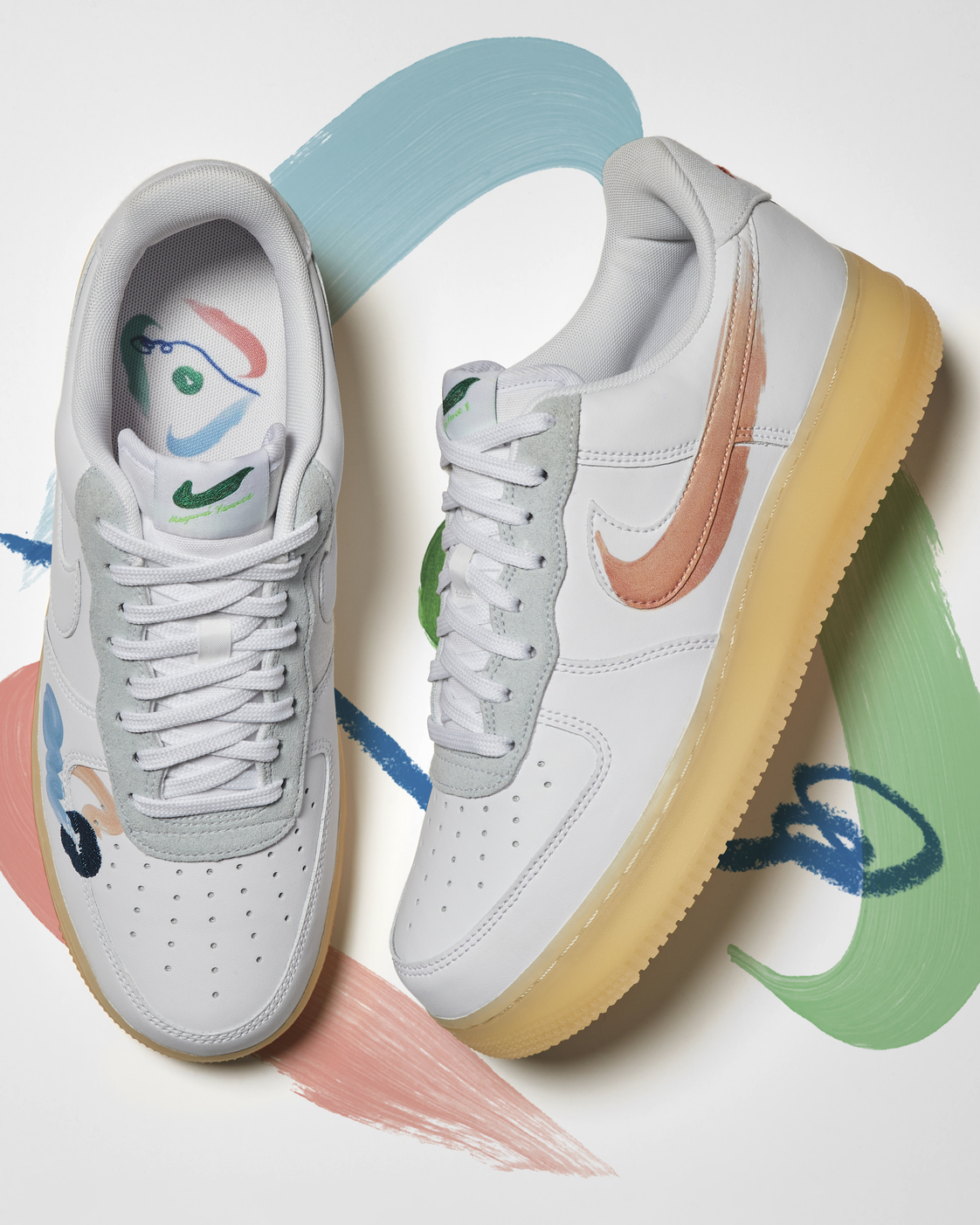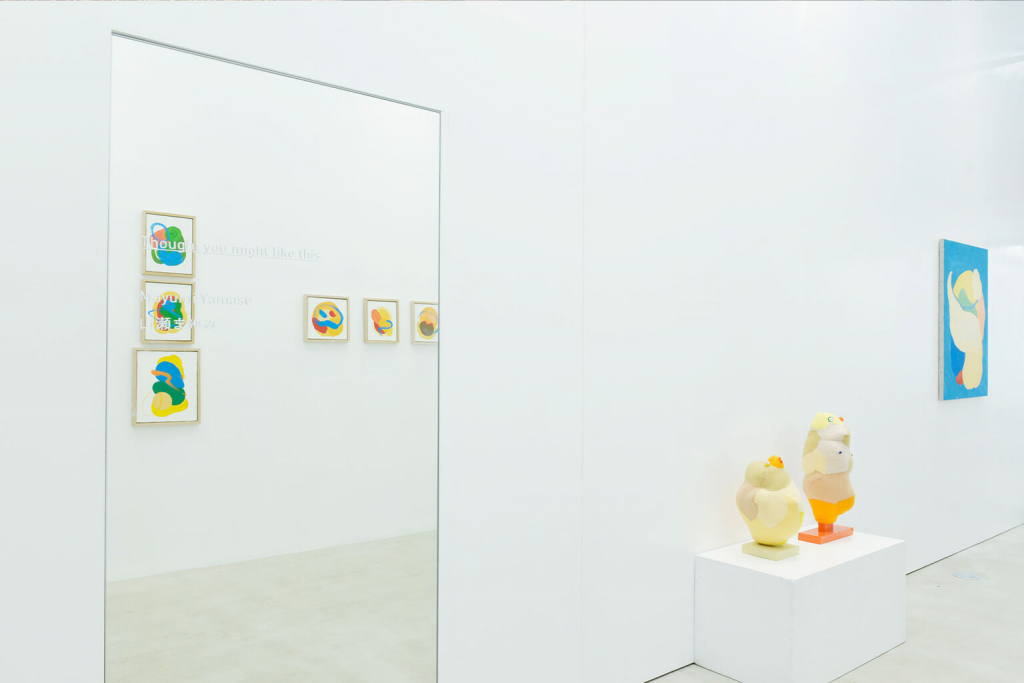When I meet Mayumi Yamase a few weeks before her exhibition opens at the I AM gallery in Tokyo’s Higashi-Nagasaki neighborhood, I’m struck by her openness and straightforward conversation. There’s not even a hint of tatemae about her, no avoiding questions or worrying about upsetting anyone with her answers. Perhaps it’s due to her childhood which saw her raised in Los Angeles, only returning to Japan for her secondary education before spending eight formative years in England at two prestigious art schools.
Wearing her “Fight With Love” Comme des Garçons handbag in which she collaborated with the fashion brand’s legendary and iconic designer Rei Kawakubo and her creative team, Yamase is suitably stylish and very much an artist sure of her own abilities.
It’s perhaps no surprise that Yamase became an artist as her parents are both involved in fashion and art. Her mother is a former animator with Hanna-Barbera and her father a vintage clothing collector. Growing up in an international and creative environment has obviously had a huge effect on her life as an artist.

Yamase, although climbing the ranks of contemporary Japanese art, is also an accomplished writer and editor. Curator of Popeye’s art page, she also works for an array of magazines including Subsequence and ANA’s inflight magazine, in addition to previous work for Studio Voice and Kinfolk.
When we sit down to talk about her burgeoning career, Yamase is keen to stress her role as a contemporary female Japanese artist, a role which she inhabits with a critical yet often unheard or undervalued voice. When I bring up the Mori Art Museum’s Stars: Six Contemporary Artists from Japan to the World exhibition of 2020 where the only female chosen was Yayoi Kusama, Yamase laughs uncomfortably.
“Being a female in Japan, and especially coming back here from the UK, I was surprised that such kind of things — the way women are viewed or treated — still happens here,” says Yamase. “But I personally try to be myself as much as possible and comfortable too. I’m also aware that as an artist I have a voice in the media and I can also write. I feel like I should really use my voice.”
Although Yamase didn’t live in Japan for long, in her younger years, she maintained healthy relationships with many of the Japanese diaspora in London during her time there as a student at University of the Arts London and Chelsea College of Art & Design. This would come to bear fruit as when she returned, she got in touch with some of the friends she had met in England who had also returned to their homeland. Two of these acquaintances would recommend her for collaborations with brands such as Comme des Garçons, an experience which would redirect her life as a creative.
“A friend of mine works at Comme des Garçons and she also happened to live in London,” says Yamase. “The department she belongs to works directly with Rei Kawakubo and she’s now in charge of bag designs there. They really like collaborations so she asked me, out of the blue, if I would be interested in doing something with them. Then I got to know the people involved more and the bag project came along. Although I had no experience doing this kind of graffiti art, I gave it a go. My friend presented the idea to Kawakubo and they asked me again and we did a few samples and then the bags became quite popular. It was only for one season, in the beginning, but now it has become one of the brand’s main handbags.”
In addition to handbags, Yamase has also worked with Kawakubo on a series of hand-painted hats and footwear. Perhaps this experience and her personal connections positioned her into the eyeline of Nike, with whom she worked on a very successful collaborative pair of Nike Air Force 1 sneakers.
“[My friend] mentioned to me about the possibility of the Nike project (and maybe because I had already worked with Comme des Garçons) he pushed my collaboration internally through them. It was nothing like I had done before and working with such a big company and having weekly meetings with them over time was a real learning process,” she says.

She has had a succession of global exhibitions including shows at Parco, Isetan and Hikarie in Tokyo, as well as galleries in London, Singapore and the US. Her work, described as abstract, plays on color, strokes and conceptual dialogues between the viewer and the artwork. In an interview with Norse Store, Yamase explains more about the conviction behind her art.
“Much of my work concerns an affinity of human life, which could be domestic, physical or a sense of living that sometimes is inspired from something inside the human body or the cellular image of a living creature,” says Yamase. “To explore such things through my work, both abstraction and metaphors of creatures are the recurring themes within my practice. These represent and manipulate ideas that may be unrecognizable at first but may still have perceived connections to something living.”
Talk soon turns to Instagram and, in particular, the artist’s viral post of Madonna sporting one of her hand-painted bags emblazoned with “Lovable Rebel” in Yamase’s signature white paint for Comme des Garçons at the MTV Video Music Awards’ afterparty. It looks like graffiti and, it can be said, taps into the brand’s early punk ethos. Yamase laughs when we talk about it and she explains that she didn’t even know about it until her Instagram direct message box started to fill up with friends screaming about it. It seems to faze her, a little, when she says that the bag has been so successful that it’s one of the brand’s most popular items and is now an ongoing project.
 When we discuss her plans for the rest of the year, she talks about her exhibition at popular music festival Greenroom, which takes place in Yokohama on May 28 and 29. The event has incorporated art into its schedule for this year and Yamase will exhibit her new work in what could be called an unorthodox location for an artist. But she explains that because of links with fashion and retail she has often exhibited at galleries or spaces which aren’t connected to art such as commercial fashion complexes like Tokyo’s Parco and Isetan. After Greenroom, the Tokyo-native plans to take a breather.
When we discuss her plans for the rest of the year, she talks about her exhibition at popular music festival Greenroom, which takes place in Yokohama on May 28 and 29. The event has incorporated art into its schedule for this year and Yamase will exhibit her new work in what could be called an unorthodox location for an artist. But she explains that because of links with fashion and retail she has often exhibited at galleries or spaces which aren’t connected to art such as commercial fashion complexes like Tokyo’s Parco and Isetan. After Greenroom, the Tokyo-native plans to take a breather.
“I actually don’t have much planned, which I quite like,” she says. “I always say yes to things so it’s nice to not have much planned.”
And with that, Yamase finishes her coffee and swishes out of the shop near the gallery, with her hand-painted handbag and long, stylish raincoat floating in the wind and an audible “sayonara” which curls and shifts like a stroke in one of her conceptual paintings.
Keep up with Mayumi Yamase at www.mayumiyamase.com









